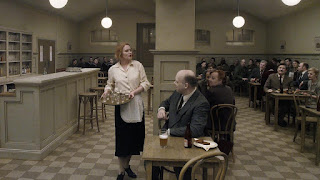A Pigeon Sat on a Branch Reflecting on Existence wins Golden Lion in Venice
By Moira Sullivan
 |
Typical Roy Andersson mis en scène |
The big news from the "Venice Film Festival" that ended on
September 6 is that Sweden’s best arthouse filmmaker after the late Ingmar
Bergman, Roy Andersson won
the Golden Lion for his film A Pigeon Sat on a
Branch Reflecting on Existence. It comprises 39 separate but thematically
connected sketches on two traveling salesmen and is part of a trilogy of films that began with his
grand prize at Cannes in 2000 (Songs from the Second Floor). After that Andersson
was hard at work again crafting a by now clearly recognizable product as far as
form and content is concerned. “You, the living” (2008) was made seven years after his Cannes award and A Pigeon Sat on a
Branch Reflecting on Existence completes the trilogy.
Andersson’s work is so completely different from anything
that directors in Sweden are producing today that he is comfortably in a class
of his own. His feature films follow the same visual style since 1991 with his
film entitled Härlig är Jorden , "World of Glory", a cynical slice of Stockholm
life, a series of handcrafted vignettes with carefully composed mis en scène and artfully arranged
slices of life. The scenes are filmed in medium or long shots, with no
close-ups, and virtually no camera movement. The color of the interiors -
Swedish apartments, offices or pubs recreated in Andersson’s Studio 24 in
Stockholm is always “nausea green”, a little like the green tint in "Soylent
Green" from the 1970s.
There is a frosty chill to these interiors with a decadent
fuzzy color stock superimposed on decrepit and deteriorating facades. These
interiors could be filmed anywhere in Europe and they often look like East
Berlin before the wall came down but they are made in Stockholm.
Today Stockholm is one of Europe’s most elegant and
beautiful cities, but in the suburbs of Roy Andersson’s concern, time stands
still with ugly brownstones and high rises from the 1960’s. Most of the inhabitants have sparsely
furnished dwellings. They are sub-basic and on the verge of spiritual decline
as far as utility. The interiors most certainly seem to match the mentality of
the characters.
The idea of a series of side-by-side visual vignettes
evolved out of Roy Andersson’s career as a commercial filmmaker. His three
latest films represent a personal artistic renaissance after years of making
commercials and a return to features.
The archetypal
Swede is the central character in an Andersson film, sometimes referred to as a “zombie”, an unattractive stereotypical label awarded
because of lulls in conversation, sparse functional language, a shyness for
helping others and showing compassion when someone has misfortune, and a
general lack of warmth and emotion. There is also a ritualized reverence to
protocol and a generational and dutiful transmission of the moral codes of the
culture. Andersson’s commercials are often good-natured digs at the conventions
of Swedish society.
Andersson’s Sweden is reminiscent of the late cold war or an
impending catastrophe. A static group pose is present in almost every Andersson
vignette: people standing in line
for a bus, sitting in a bar or waiting for an elevator. No one small talks with
their neighbor because they don’t really know them even if they have seen each
other for years. These generic
qualities have perhaps given Andersson the distinction of making universal films
with universal themes. But his films rightly so are particularly Swedish. More
than anything there is a sense of impending doom which makes Roy Andersson a
unique and cathartic art house director. His latest edition
© 2014 - Moira Sullivan - Air Date: 09/10/14
Movie Magazine International
Comments
Post a Comment